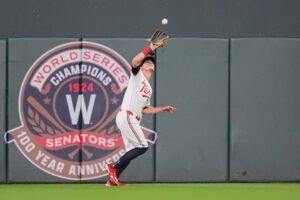Adrián Beltré was not considered a challenger to a level of player excellence in the likes of Mike Schmidt and George Brett. By the time Beltré ended his career, however, all Hall of Fame debates about the newest inductee were over. Beltré is a rare case as he was not on track for Cooperstown when he hit his age 30 season. He was a good player with one great year, but here’s the thing. Players like Buddy Bell and Ron Cey, who were likely to miss the hall, were all better players in their twenties compared to Beltré.
Below is a chart of Beltré’s career splits by age-season.
|
Age 20-30 |
Stats |
Age 31-37 |
| .272 |
Batting Average |
.310 |
| .327 |
On-Base % |
.359 |
| .456 |
Slugging % |
.521 |
| 106 |
OPS+ |
133 |
| 4.0 |
WAR/Season |
6.2 |
As noted in the chart, Beltré hit .272 while slugging for .456, and his 106 OPS+ was barely above the league average. But then, he hit another level entirely, and for the next seven full seasons, he hit .310 with a .521 slugging percentage. If you put both halves together, that’s a Hall of Famer right there.
There are 17 Hall of Fame third basemen. It will soon be 18 once Beltré is inducted in July. But that position has the fewest inductees than others in baseball (minus the designated hitter, of course). Yet, some of baseball’s best defensive players and power hitters have played at the hot corner of the baseball field. Here are the top six WAR leaders among third basemen.
Writers note: Baseball-Reference WAR is used for this article.
WAR Leaders Among All Third Basemen
Chipper Jones, 85.3
Chipper Jones switched from shortstop to third baseman while in the Atlanta Braves minor league system. He placed second in National League Rookie of the Year voting in 1995, just days after helping Atlanta end a 38-year championship drought. Jones made the postseason in each of the following seasons and won two more pennants along the way in 1996 and 1999. Jones was named an All-Star eight times, won NL MVP in 1999, and leads all third basemen in batting runs with 558. Chipper also has the most postseason plate appearances, with 417, while representing a National League team. He is one of seven players with 400 home runs, 500 doubles, and 1,500 walks.
George Brett, 88.6
Brett is one of four players to rack up 3,000 hits, 300 home runs, and a .300 batting average—the others: Stan Musial, Willie Mays, and Hank Aaron. Between flirting with Ted Williams‘s .400 average in 1980 or the 1985 season, Brett outhit Don Mattingly despite not getting his second American League MVP Award. But, a World Series ring made up for the third baseman with the fifth-highest WAR among his peers. He remains the most important player in Kansas City Royals history.
Wade Boggs, 91.4
Wade Boggs was an All-Star 12 seasons in a row and for good reason. It was a streak that crossed his paths with the Boston Red Sox and New York Yankees. His plate discipline was spectacular as he led the league in OBP six times and rarely swung and missed. In 1985, his .368 batting average was a career-best. But most of all, it was the highest mark by a Red Sox player since Ted Williams hit .388 in 1957. His 240 hits that season were the most in baseball in 55 years. Boggs’ 91.4 WAR is supported by his career .328 batting average, in which he led the majors five times.
Adrián Beltré, 93.5
By the time he retired, Beltré had the most hits and total bases of any third baseman in the history of the game. He was a superior defender with the glove, and his career WAR is reasonably impressive, too. A good Hall of Fame mark for WAR is 60. Beltré is at 93.5, which helped become a lock on the ballot. It was a slow start to his career, but his numbers put his case beyond any argument. Over a six-year stretch with the Texas Rangers, Beltré hit .308/.358/.516 with 167 home runs, 563 RBI and 32.4 WAR, seventh most in the majors. He earned three All-Star selections, won two Silver Sluggers and three Gold Gloves for Rangers teams that were consistently competitive.
Eddie Mathews, 96.0
Before Henry Aaron, Eddie Mathews was the slugger for the Braves. Mathews is the only player to play in all three cities the Braves franchise called home. He hit 40 homers in a season four times in his career. He finished with 512 home runs, including a streak of at least 30 for nine consecutive years. His 47 home runs in 1953 established a single-season record for a third baseman that would last almost 30 years. The 12-time All-Star led the NL in walks four times and was a two-time runner up in the NL Most Valuable Player Award voting. When he retired, he held the third base record for games (2,181), assists (4,322), and chances (6,371).
Mike Schmidt, 106.8
In terms of WAR leaders, there is a reason why Schmidt is the best third baseman to play. He is ten points higher than Mathews, and he will forever be known for his top-tier power. He provided dazzling defense playing at the hot corner for years as he won 10 Gold Glove Awards. From 1974 to 1987, Schmidt posted 5.0 WAR or higher while winning three NL MVP Awards, including back-to-back seasons in 1980 and 1981. He was an All-Star 12 times and led third basemen in assists seven times. His highest WAR mark was 9.7 in 1974, when he finished sixth in the voting.
Photo Credit: © Jennifer Buchanan-USA TODAY Sports






